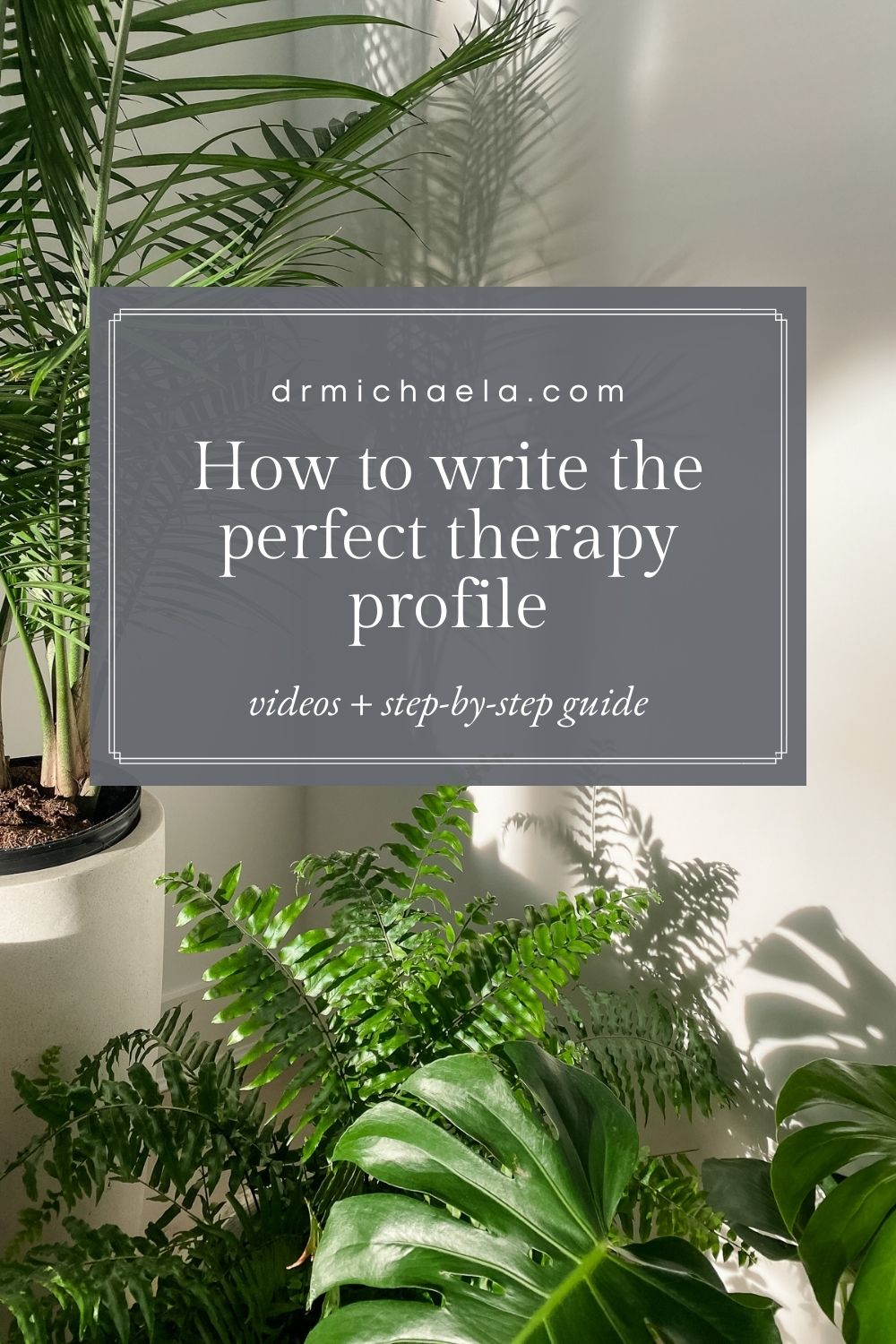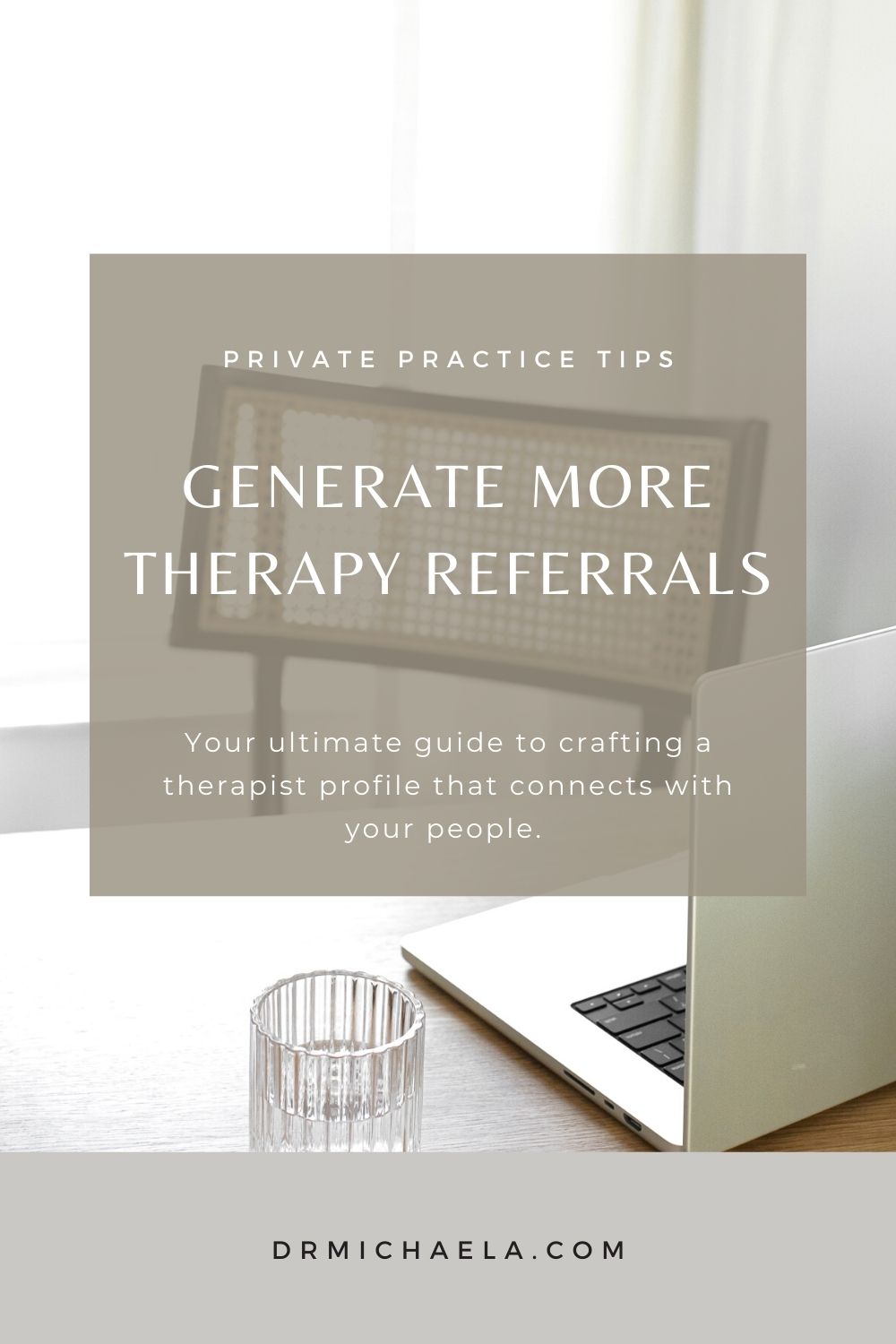How to rock your Psychology Today profile

Table of Contents
- Introduction
- Step 1: Start with a mindset shift
- Step 2: Get to know the lay of the land
- Step 3: Know who you're speaking to
- Step 4: Note (and then ignore) the limits
- Step 5: Personalize your personal statement
- Step 6: Offer necessary details
- Step 7: Add in the extras
- Step 8: Suggest (+ prepare for) a clear next step
- Step 9: Test, tweak, and repeat
- Step 10: Update as needed
- Psychology Today FAQ
- Recommended resources
- Let's take action
- Share this post
It’s one of the first impressions your dream client will get of you and your practice.
It’s widely considered the default professional directory in our field. (For better or worse.)
And it’s, hands down, one of the most frequently missed opportunities we have to connect with the clients we’re trying to reach.
If your Psychology Today profile isn’t generating a steady stream of (dreamy) referrals…
OR
If you haven’t created a Psychology Today profile yet, and have no idea where to start…
You’re in the right place, friend.
Read on for 10 steps to absolutely rock your Psychology Today profile:
1. First things first: Time for a mindset shift.
What do you associate with your Psychology Today profile right now?
- Are you cautiously optimistic about it’s potential as a referral source for your practice?
- Frustrated by the lack of return you’re seeing on your investment, month after month?
- Or are you indifferent? (After all, it’s just a professional directory, right?)
No matter how you currently feel about your Psychology Today profile, this post can help you improve it.
When everything clicks into place, your profile should become one of the leading sources of quality referrals to your practice.
It should also be a strong representation of you + your work, as it’s one of the first hits that comes up when anyone Googles your name.
But, that’s not the whole picture...
Your Psychology Today profile is also helping shape the public’s impressions of therapy, health/wellness providers, and mental health.
(For better or worse.)
How? Let’s think about it:
Even the most effective profile will have a relatively high “bounce” rate, meaning most folks who land on your profile will, at some point… bounce. They’ll choose not to contact you.
That’s simply the way the odds work. (And to be clear: Improving your profile quality WILL lower your bounce rate).
But, how can your profile help even those people who choose not to work with you?
- It can provide them with the info they need to determine you’re not a good fit.
- It can offer insight into a struggle someone else in their life may be dealing with.
- It can give them an interaction with our field that feels safe, welcoming, and empowering.
See? Your Psychology Today profile isn’t wasted on anybody.
What an opportunity, right? Let’s take it.

2. Get to know the lay of the land.
If you haven’t already, I highly recommend creating an account ahead of time, so you can do a bit of exploring, and familiarize yourself with the layout before you actually begin to set up your Psychology Today profile.
Not a therapist? Psychology Today’s sister platform for other health professionals, HealthProfs, follows nearly the exact same format!
To create an account, you’ll need to input the following info:
- Name
- Location + contact info
- Therapist type (chosen from a dropdown menu)
- Credentials (number, state, and expiration date of your license, if you have one; Psychology Today will use this information to verify your profile, which can take a few days, but you’ll be able to start accessing your account immediately)
- Billing info (set by default to a recurring charge, unless you cancel)
Once you’ve created your account, you’ll be free to click around and explore the different fields via a navigation menu.
But, in the meantime, here’s the whirlwind tour of the back-end of your profile:
Name
In addition to the info you’ve already provided, this tab is where you’ll also have the option of including a website link.
Address + Phone
Here’s where you can add a second practice location (if you have one).
You can also let Psychology Today know where you’d like your bimonthly magazine (subscription included with your profile registration) sent. For instance, you can have it sent to your home address, to your practice location (e.g., for waiting room reading material), or you can opt out of receiving it.
Credentials
Under this tab, you can add in your recent education, years in practice, and any additional credentials/memberships.
Specialties
This tab compiles information about — you guessed it— your areas of specialty.
Treatment Preferences
This is where you can indicate specific types of therapy you provide, as well as the modality (e.g., group, individual, couples).
Client Focus
Focused primarily on client demographics, this section enables you to identify additional languages you’re proficient in. (It also gives you the option to provide a personal statement in more than one language.)
Finances
In addition to details about your pricing and payment methods, this is also where you can list any insurance information.
Personal Statement
This is the heart of your Psychology Today profile… and often the most neglected section!
It’s actually broken down into 3 separate text fields, each with its own prompt.
But more on that later…
Groups
Did you know you can list details + description for up to 3 groups on your Psychology Today profile?
Few people do! And even fewer take advantage of it.
Photos
Here’s where you’ll add your profile photo + any other photos you may wish to include.
Target Your Area
Based on your primary practice address, Psychology Today will automatically populate this section with a city, state, and zip code.
You have the option of adding 2 other service areas, which helps your profile show up in search (both on the platform itself + in organic Google search).
(For example, in addition to the city where your practice is located, you might list the 2 largest neighboring cities.)
So, that’s your basic Psychology Today profile, as viewed from the inside!
Now, if you haven't already, I suggest you spend some time on the platform, perusing different profiles from the front end, as they appear to the public. That’ll help you visualize how the different parts of your profile will come together, too.
Go ahead and do some exploring right now… I’ll wait here. ;)
3. Know who you’re speaking to.
Of all the advice in this post, this is the most vital to the success of your Psychology Today profile:
You must know who you’re trying to reach.
Most therapists cast far too wide a net in drafting their profile, in the hopes of reaching as many prospective clients as possible.
And while it’s certainly not a bad thing to want to maximize your reach + help as many people as you can…
It’s not a winning strategy for connecting with your dream client.
In other words:
Try to appeal to everyone, and you’ll end up reaching no one.
So, what should you do instead?
The exact opposite:
You need to get super-specific about who you’re trying to reach. And then you need to craft your profile so it speaks directly to that one person.
Now, if the thought of narrowing your focus makes your palms sweat + your mind start racing with scary thoughts of lost income, take heart:
- No, you won’t lose business.
- No, you won’t attract the same exact client over and over.
- And no, you aren’t morally obligated to try to work with every client on the planet.
These beliefs are real, and they’re understandable. But they’re getting in your way.
If this whole concept is totally new to you, let me tell you what I mean by “dream client”.
Your dream client is someone who:
- You love to work with.
- Truly benefits from your unique value.
- Recognizes that value + shares it.
As you prepare to set up your Psychology Today profile (and especially as you prepare to write your personal statement), it’s important to think about who fits this description for you.
It might be a current client. Or someone you’ve worked with in the past. Or a composite of qualities you’ve mashed up into one dreamy idea of a client.
And while you’re at it, you might as well get clear on who you’re not trying to reach, as well. That’s just as important!
(Oh, and don’t worry about pigeonholing yourself. You’ll have ample opportunity to advertise the variety of issues you work later on in your profile.)

4. Note (then ignore) the limits
OK, friend. This is the part where we (finally) get to your personal statement.
Now, I happen to think it would be really cool if Psychology Today would just give you a nice, big, open text field and let you write whatever the heck you want there…!
But, alas, when you click over to the Personal Statement tab, what you’ll find instead is a series of 3 text fields.
Each with it’s own prompt. And (super arbitrary) character limit.
I know. I can hear your outrage already…
“Essay prompts?! Where are we, MIDDLE school?!”
“Character limits?! What is this, TWITTER?!!”
I’m with you. But, take a deep breath + please trust me when I say:
We can work with this.
Here’s how:
First, you can go ahead and ignore those prompts.
(You really can.)
They won’t show up on your actual profile. They’re simply there to help guide your thinking.
And to be fair: The prompts aren’t bad at all. They’ve actually evolved quite a bit since the inception of Psychology Today’s “Find a Therapist” directory, and they’re consistent with a lot of the copywriting advice I give on this very blog!
But, as it turns out, following the prompts is one of those rules you truly can break.
When it comes to approaching the actual writing of your personal statement, I think it works best if you simply treat it like 1 cohesive statement broken into 3 paragraphs.
Because that’s exactly what it is.
Second, you absolutely can (and should) write the whole thing in a separate document.
This will help you think more clearly about what you want to say, without feeling confined to the specific prompts.
So, pull up a Google Doc or blank page in your notebook, and give yourself full permish to fully explore the space!
Oh, and don’t worry about those character limits either. We’ll deal with that later.
5. Personalize your personal statement.
Now that your mind is (hopefully) a bit more at ease, let’s turn to the actual goal of your personal statement.
A good personal statement should make your dream client sit up + take notice. And, ideally, take the next step to get in touch with you.
And I don’t think I’m dropping any shock bombs when I say that most therapists’ personal statements… aren’t good.
Why, though?? We’re smart + talented people, after all!
Most of the time, it comes down to one (or both) of these issues:
- We write for too wide an audience.
- We make it all about us.
The first of these issues we’ve already covered (in Step 3, above), so let’s move on to the second issue:
We treat our personal statement like a mini-autobiography.
It makes sense that we would. I mean, by the time we sit down to write this thing, most of us have had years of experience distilling our professional selves into CVs/resumes, cover letters, and professional bios. Could your Psychology Today profile be so different?
Yes. Yes, it could be. It’s gotta be.
Your personal statement must accomplish so much more than simply relaying your professional background + theoretical orientation.
First off, it’s gotta resonate with your dream client. (Not likely to happen when you’re leading with something like, “As a licensed clinical counselor, I…”.)
Next, it has to validate their particular struggle or challenge.
Finally, it must position you as uniquely well-suited to their needs + struggles.
And, it’s gotta accomplish all this in what amounts to 3 very brief paragraphs.
So, how do we tackle this?
I recommend you follow a formula or recipe.
There are all kinds of recipes in the world of copywriting. But, I’ll cut right to the chase + share the one I believe works best, most of the time, for most people, within the unique confines of the Psychology Today profile:
Attention-grabber –> Struggle –> Solution
Let’s take these one at a time, shall we?
Attention-grabber
This is the copy that’ll kick off your personal statement. So, it’s gotta be good!
Lots of therapists open with something like “Welcome!” or “I’m glad you’re here….” or “If you’re reading this…” but these don’t add value to your statement. They only eat up precious real estate.
Some of my favorite attention-grabbing strategies include:
- opening with a quote: sounds easy, but the quote must relate meaningfully to the rest of your statement, or else it risks ringing a bit hollow
- posing a question or series of questions: designed to mirror their current struggle
- dropping them mid-scene: describe their current struggle as though you're right there in it with them. (This is especially effective if you’re a natural storyteller!)
Whatever strategy you use, it should stand out to your dream client + set the stage for what’s to come…
Struggle
Here’s where all that reflection you did in Step 2 above will really pay off.
You already know who you’re speaking to, so now you simply have to speak to what they’re struggling with.
You should name it, and describe it so clearly that they can’t help but see + feel themselves in your description.
A couple quick tips:
- Jargon = the death of connection. All those terms you use in your case notes + conversations with colleagues? At best, they’re meaningless to your dream client. And at worse, they’re disconnecting. So, as your write, root out every instance of “chronic marital discord” and replace it with “in yet another standoff with your spouse”.
- Focus on just 1 or 2 primary struggles. There’s simply not space to describe several challenges your dream client is facing. And listing them out isn’t compelling. So, pick a couple (at most) and paint a picture of what they’re experiencing.
- Use their words wherever you can. This is always, always more effective than your wordsmith-ing their struggles yourself. You can think back to phrases you’ve heard clients use in sessions, the way they first describe their presenting concerns, even the things you’ve said that tend to resonate with clients over and over.
By naming your dream client’s struggle (in word’s they’d actually use), you’re validating their experience, and letting them know you understand what they’re going through.
Solution
Finally, your personal statement should pivot to a way out of their current challenge.
One highly effective way to achieve this is to describe how life will feel different for them when they’re no longer struggling in the same way.
Note that this is NOT the same thing as listing the specific therapeutic interventions you’ll use. Doing so rarely translates to meaningful connection.
(While it’s true that some people will be searching for a particular modality or orientation (e.g., EMDR, CBT), the best strategy is to list these in the Specialties, Treatment Preferences, and Credentials sections of your profile. That’ll ensure your profile shows up in search when these keywords are entered.)
Your final task is to position yourself as the unique link between where they currently are + where they wish to go. You’re not trying to alleviate all their concerns right there on your profile… rather, you’re hinting at a more hopeful future + letting them know you’re standing by, eager to help them get there.
This doesn’t have to be elaborate. Just speak to them like the human you are:
I can’t wait to hear from you.
I’m ready when you are.
Curious to learn more? Let’s talk.
Once you’ve drafted a personal statement that incorporates all these recipe ingredients (attention-grabber / struggle / solution), go ahead and see where you can slice it into 3 parts.
NOTE: These don’t necessarily need to map onto your recipe components, but Psychology Today will format your statement into 3 distinct paragraphs. (And again, each has it’s own character limit.)
So, I recommend you plop your statement into the 3 text fields you’re given, and just start making cuts + changes from there.

6. Offer (necessary) details.
Once you’ve got your personal statement in place, the rest of the details become a lot simpler to sort out.
Since you’ve focused your profile on your dream client, it’s time to round out that picture by coloring in some of the other dimensions of your work.
Here’s where the Specialties, Treatment Preferences, and Client Focus sections come into play!
On the platform, the options you select will function both as keywords that’ll help your profile appear in organic search + as clickable filters on the home page, which visitors can use to manually narrow their search.
I recommend you focus on your Specialties.
It’s all about using these strategically.
Psychology Today lets you select up to 3 “Top Specialties” from a dropdown menu of options. (These appear bolded in green in the margin of your profile.)
I recommend choosing the specialties for which you most wish to be known. These should overlap with the dream client struggles you highlight in your personal statement.
After that, you’re allowed to pick as many other specialties as you like. I recommend exercising restraint here.
Your goal is to represent the breadth of your best, dreamiest work… not to provide an exhaustive list of every issue you have or could conceivably handle.
You can write in 2 of these yourself. (For instance, “body image” doesn’t appear among the preset options, so I added that one to my profile.)
Another oddity of the platform: Your options are divided into 3 categories: Issues, Mental Health, and Sexuality.
From the Issues and Mental Health options, I suggest choosing 5 to 10 (total) to highlight.
Then, from the Sexuality list, I suggest selecting all options that fit with your competency. (These will all appear in the margin of your profile.)
In choosing your specialties, it’s important to remember that the human mind often operates on shortcuts + assumptions. (This is especially true when they’re under pressure, say, to find the right therapist!)
For example, if you present as female in your profile photo, many visitors will assume you work with women (whether or not you actually do) and maybe even specialize in “women’s issues”. Given this, you might opt to exclude “Women’s Issues” from your list of top specialties and use that space to highlight another focus of your work instead.
7. Add in the extras.
Of the possible extras you could include on your Psychology Today profile, I’d mainly focus on the essentials:
Your profile photo
Don’t obsess over this, but don’t dismiss it either. Your profile photo is one of the first pieces of information that’ll catch you dream client’s eye.
No matter who you’re trying to reach, a few truths are universal:
- Your face should be clearly visible. That action shot of you repelling off a cliff may impress your friends on social media, but your dream client wants to see what you actually look like.
- You should be smiling. This is not the time for a ponderous shot of you staring out onto the horizon. It’s not an album cover. Regardless of your unique style + approach, your photo should convey warmth and openness. (Unless your style is specifically opposed to warmth and openness, in which case… yikes. ;)
- It should be professional(-ish) quality. Look, you don’t have to splash out on an elaborate, big-ticket photo shoot just to yield 1 good image. But, you do need to take it seriously. Plenty of photographers offer deals on professional head shots. At the very least, find your friend who always has the newest iPhone the moment it's released (you know which friend I’m talking about…) and ask them to help you stage a little shoot of your own.
Psychology Today’s image upload tool currently has just a couple of basic functions: You can rotate your image and crop it to your liking. (Again, I recommend zooming in, so your face is clearly visible.)
Website link
This link will appear as a button under your profile photo, along with any other call-to-action buttons you elect to include (e.g., Send to Friend, Email Me).
Most people simply link to their website home page, but you could also direct visitors to a dedicated Contact page on your site to help streamline the process.
(Don’t have a website yet? Hate the one you have? Under construction? Don’t sweat it. Visitors will find all the info they need to contact you right there on your profile. So, don’t let a lack of website keep you from publishing your Psychology Today profile. Just get this up for now, and then work on getting that website going next!)
OK, once you’ve got your profile photo and website link in place, you can move on to the remaining (optional) bits and pieces.
Not strictly essential, but worth at least considering are:
Office photos
Sharing photos of your space is a great way to help your dream client envision themselves working with you.
Remember, it’s not about giving them ALL the information at once. It’s simply about guiding them through the process of connecting with you, one step at a time.
Take a few minutes to think (again) about your dream client:
- Are they new to therapy or more seasoned? Nervous, excited, uncertain…?
- What questions might they have about your office environment?
- Are there practical considerations (e.g., accessibility) you can address visually?
- Any aesthetic features you’d like to share with them?
Use your answers to guide your selection of office photos. It’s totally up to you, but if you’re looking for some suggestions, I’d recommend including:
- An external shot of the building. Even if it’s hideous, it’ll help clients locate you.
- A bright shot of the space where they’ll be meeting with you.
- The reception area (if you have one) + any other spaces you wish to highlight.
I wouldn’t bother with:
- A close-up shot of your business card. This is more common that you think + a total waste of space as they’ve already got all this info right there on your profile!
- Dimly-lit or low-resolution images of anything. They’ll only work against you.
- Stock photos of any kind. Keep your photos specific to you + your space, or don’t use any at all.
Professional connections
Depending on your niche and/or your geographical market, this might be meaningful information to your dream client. But, most likely not.
(Including some well-chosen connections can help get your profile in front of new referral sources, however. So, depending on your current goals, it might be worth spending a few minutes on this.)
Additional credentials
Again, Psychology Today limits your options here, in ways that are kind of arbitrary...
First, you’re limited to 2 additional credentials.
Then, for each credential you enter, you’re forced to choose the Type from a dropdown menu of options:
- certificate
- diploma/degree
- license
- membership
…and you’re given 2 open fields to complete:
- accrediting institution
- certificate ID / number
…along with one that’s restricted to a numerical value:
- year (YYYY)
(Don’t ask me why they structure it this way. I have no idea. What I do know is, it’s not a big deal.)
Here’s what I suggest:
- Think about which credentials (e.g., trainings, certifications, specializations), if any, will be most meaningful to your dream client.
- Pick your top 1 or 2.
- For each credential, choose a Type from the dropdown box. (On the fence or have no idea? Pick “certificate”.)
- Fill in the Accrediting Institution + Year fields with the relevant info.
- OK, you know where it says Certificate ID / Number? Write whatever you want. I mean, don’t falsify info, obviously. But, instead of stressing yourself out over whatever the heck Psychology Today means by “Certificate ID / Number”, you should feel perfectly free to write something more reasonable (and substantive), like “research fellowship” or “EMDR training” or “art therapy designation“).
Verified badge
Some therapists wonder about opting it to have the “Verified by Psychology Today” badge displayed on their website.
Honestly, I wouldn’t bother because:
- Aesthetically, it’s… kinda ugly. Don’t go to all the trouble of building a beautiful practice website only to crowd it with an image that detracts from the overall look you’ve created.
- It’s not particularly meaningful to your dream client.
- It’s redundant. By default, once Psychology Today verifies your credentials, you’ll see a clear check mark at the top of your Psychology Today profile.
But, if you’d still like to include a reference to Psychology Today somewhere on your site, I recommend finding a way to integrate it more seamlessly into the design of, say, your home page. (This could be as simple as a brief note in the footer.)

8. Suggest (+ prepare for) a clear next step.
Don’t go to all the trouble of crafting a beautiful Psychology Today profile only to leave your dream client in the lurch…
Invite them to take the next step toward working with you!
Fortunately, Psychology Today makes it pretty easy for you to do this:
- When you input a phone number, it’ll be displayed as a clickable link.
- When you input an email address, it’ll be displayed as an Email Me button.
- When you input a website URL, it’ll be displayed as a Website button.
(By default, visitors will also have the option of sharing your profile via a Send to Friend button.)
But providing a next step for your dream client to take is only the beginning! You’ve gotta be prepared for them to actually take that step.
Ask yourself:
- Where am I sending my dream client? Where are they headed next from my profile?
- Are they calling? Who’s answering the phone? (Me? An assistant? An answering service?)
- Are they emailing? Who’s monitoring that account?
- Who’s managing + tracking incoming contacts? What kind of response time can my dream client expect?
- Do I offer a consultation? Via phone or in-person? How long does it last? Is it free?
Anticipating these questions (and getting clear on the answers!) is a too-often-overlooked part of the Psychology Today profile process.
Do everyone a favor and take the time NOW to outline a basic process for helping them transition from profile visitor to scheduled client.
Your future self (and your future dream clients!) will thank you.
9. Test, tweak, and repeat
As satisfying as it feels to finally see that profile go live… it doesn’t end there.
In fact, you should be thinking about your Psychology Today profile as a living, breathing, dynamic thing. It should grow + change as you do.
So, every now and then, pull up your profile and take an honest inventory of what you see:
- How does it align with your current niche? Your current dream client?
- Does it represent your authentic approach to your work?
- Does any part of it feel “off” to you?
If it’s time for a change, you could:
- switch out your profile photo
- play around with specific wording/phrases
- target a new (or slightly different) dream client
- adjust your listed specialties, etc.
You don’t have to knock yourself out with this. (I probably do this kind of mini-audit on my profile about quarterly, but you could make it an annual tradition if that’s easier.)
And you don’t have to rely solely on instinct either! You can take a more data-driven approach with the monthly analytics reports Psychology Today sends you.
These include:
- # of searches for help in your city + zip code
- # of views to your profile
- # of emails sent to you via your profile
- # of clicks to your website
- # of phone calls to you
- # of people who shared your profile with a friend
I recommend tracking these stats month-to-month, so you can start to measure your progress + identify patterns following each tweak you make to your profile.
10. Update as needed
As you continue to monitor how your Psychology Today profile is performing, you'll likely start identifying opportunities to update and improve it.
Fortunately, I've got a growing library of resources to support you in this!
Psychology Today Frequently Asked Questions (FAQ)
Since publishing this post, I've kept track of specific Psych Today profile questions that have come up in search. (I'll continue to add to this section as new questions come in.)
How do I cancel/delete/permanently deactivate my profile?
As simple as this process should be, there's a lot of confusion online about just how to do it! In this very brief video, I share exactly how to remove your profile listing:
What does "verified by Psychology Today" mean? How long does it take?
Ever wondered what information they're actually checking while you await verification by Psychology Today? Check out this quick video clearing up the confusion:
A few final words of encouragement…
- DON’T give yourself ages to work on this. Your brain is a powerful asset that can do remarkable things given the proper guidance + time constraints. Set a timer, and prepare to amaze yourself!
- DON’T let fear sideline your progress toward a stellar Psychology Today profile. Your dream client is waiting on you, friend.
- DO remind yourself (often) that you're shaping public perception of therapy. A clear, targeted, authentic profile is not only good for your practice + your dream client… it’s also good for the folks who’ll land on your profile decide not to work with you. Let’s show ’em what our field is made of + help spread the good word!
Recommended resources
Want to explore more ways to use your Psychology Today profile to market your health + wellness business? Check out these blog posts:
- Psychology Today profile tips (2021 UPDATES)
- Are you making these Psychology Today profile mistakes?
- How to market your therapy practice in multiple states
- How to write great private practice website copy
Let's take action!
Ready to implement what you learned in this post? I like your style!
- Pull up your Psychology Today profile + choose 1 of the tips in this post to start improving it where you can.
- Looking for copy support? Take the Copy Vault Challenge!
- Want more actionable tips + real-life examples to help you reach more of your dream clients? Join my email list!
Find this post helpful?
I'd love it if you'd share it with a health/wellness professional in your community!

So, now you've had a taste. Wanna see what else I've cooked up for you?
Get a fresh dose of my best encouragement, resources + guidance, delivered right to your inbox each week!


